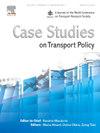Societal costs and benefits analysis of integrating bike-sharing systems with public transport: A case study of the public transport bike (‘OV-fiets’) in the Netherlands
IF 3.3
Q3 TRANSPORTATION
引用次数: 0
Abstract
Integrating bike-sharing programs with public transport enhances accessibility and car-independent mobility, yet a comprehensive societal cost-benefit analysis of this integration remains scarce. This study addresses this gap by conducting an ex-durante analysis of the OV-fiets program in the Netherlands, a station-based round-trip bike-sharing system designed to improve last-mile connectivity for train commuters. The analysis reveals that in the average (balanced) scenario, the net present value (NPV) of the OV-fiets scheme is positive, with a benefit-cost ratio (BCR) of 1.5. This indicates that the scheme has benefited the Dutch society over the 20-year period (2004–2023). In the pessimistic scenario, the NPV remains slightly positive with a BCR of 1.1. This implies that even under the least favourable conditions, where high costs and low benefits are assumed, the scheme still slightly exceeds the break-even point. Conversely, in the optimistic scenario, the BCR rises significantly to 2.4. Primary benefits include enhanced accessibility, reduced road congestion, and improved health outcomes. This research underscores the considerable societal value of the OV-fiets program in the Netherlands, warranting continued investment in the program and emphasising the need for ongoing bicycle safety measures and infrastructure improvements. However, OV-fiets might be successful in the Netherlands; our analysis also shows that copying it into other contexts is not straightforward. The seamless integration of bikes with trains is crucial, and the operators should be able and willing to accept operational losses.
自行车共享系统与公共交通整合的社会成本和效益分析:荷兰公共交通自行车(“OV-fiets”)的案例研究
将自行车共享计划与公共交通相结合,可以提高可达性和无车出行能力,但对这种整合的全面社会成本效益分析仍然很少。本研究通过对荷兰的OV-fiets项目进行临时分析,解决了这一差距。这是一个基于车站的往返自行车共享系统,旨在改善火车通勤者的最后一英里连通性。分析显示,在平均(平衡)情况下,OV-fiets方案的净现值(NPV)为正,效益成本比(BCR)为1.5。这表明该计划在20年期间(2004-2023年)使荷兰社会受益。在悲观的情况下,净现值仍略为正,BCR为1.1。这意味着,即使在最不利的条件下,即假设成本高收益低的情况下,该计划仍略高于盈亏平衡点。相反,在乐观情况下,BCR显著上升至2.4。主要益处包括改善可达性、减少道路拥堵和改善健康结果。这项研究强调了荷兰公共自行车项目的巨大社会价值,保证了该项目的持续投资,并强调了持续的自行车安全措施和基础设施改善的必要性。然而,OV-fiets可能会在荷兰取得成功;我们的分析还表明,将其复制到其他环境中并不简单。自行车与火车的无缝整合至关重要,运营商应该能够并愿意接受运营损失。
本文章由计算机程序翻译,如有差异,请以英文原文为准。
求助全文
约1分钟内获得全文
求助全文

 求助内容:
求助内容: 应助结果提醒方式:
应助结果提醒方式:


